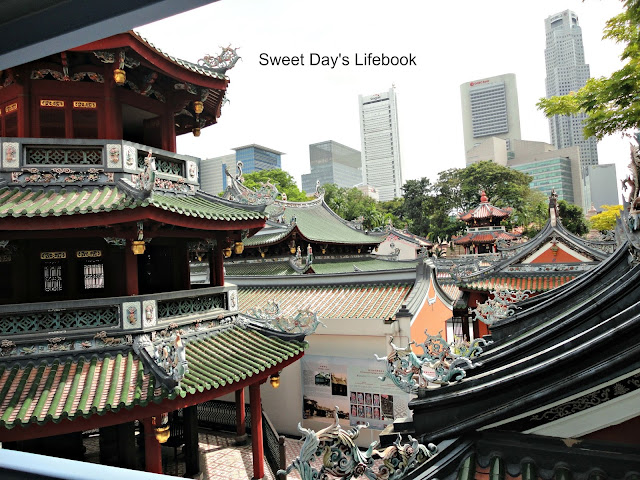Organised in conjunction of the Singapore Heritage Festival (SHF), we registered with Singapore Musical Box Museum to enjoy a free admission as well as tour. The trip was a truly eye opener! I did not know that they come in all sorts of sizes. The 2 wonderful guides explained to us the history and evolution of musical boxes. I am totally impressed! I believed those who are with us were too!
 |
| Singapore Musical Box Museum |
 |
| Music boxes are similar to the chime mechanism of old clocks. |
 |
| Mandolin Tremolo Zither (Switzerland) 1880s. |
 |
| Left: Roller Gem Organ (USA)1885 reminds me of a typewriter Right:Musical box with storage drawers |
Below is a Polyphon Table Model Style 45. (Germany)1890s
 |
| Doesn't this reminds you of a vinyl player? |
 |
| Left: How a punched disc looked like Right: Other Disc musical box include a Britannia |
 |
| Giant cylinder of the "Atlantic" |
 |
| Polyphon Giant Music Box |
 |
| This is a precursor of the jukebox! Look at the number of disc it has! Yes, you can choose which song you want it to play. |
Are you surprised to know that Singapore manufactured musical box as early as late 1800s? I am! The guide explained that as Singapore was under colonial rule, the British had taught Singapore craftsmen how to repair watches and clocks. Subsequently, when musical boxes were brought into the country, the same craftsmen would repair and maintain, eventually going on to make the musical boxes themselves.
I wonder what tune would "China" play. Unfortunately, it is still waiting for restoration.
If you wonder, why it was named "China", we were told, during the colonial time, any place in the East was considered China. Hence, this piece of work is consider that from China.
 |
| "China" |
 |
| Limited edition scarf by Hermès made in 1996 and a musical cigar holder in front. |
 |
| The musical cigar holder. It's mind blowing that people use musical for almost anything, not just for pure entertainment. |
The guides even ask us to take a look at the architecture of this place.
 |
| View of Chong Wen Ge Pavillion, Thian Hock Keng and Singapore Yu Huang Gong temples |
Chong Wen Ge was the first education institution set up by the Chinese community in Singapore. Thian Hock Keng Temple is Singapore’s oldest Chinese temple. Both gazetted as national monuments in 1973.
"Chong Wen Ge In the past, two institutions flanked Thian Hock Keng: Chongwen Ge (崇文阁, ‘Institute for the Veneration of Literature’), Singapore’s first Chinese school; and (庆德会), a private Straits Chinese self-help association. In 1849, an outstanding Hokkien Peranakan merchant, Tan Kim Seng (陈金声), spearheaded the construction of Chongwen Ge. Besides the Hokkiens, members of the Hakka and Teochew communities also contributed generously to the project. Originally, Chongwen Ge comprised the Chongwen Pagoda and Chong Boon Gate. Chong Hock Pavilion was added in 1913.
Having outgrown its facility within the temple grounds, Hokkien Huay Kuan moved into Chong Hock Pavilion in 1915. That same year, it established Chong Hock Girls’ School (崇福女校), one of Singapore’s earliest Chinese schools for girls. The name ‘Chong Hock’ (崇福) was an honorary title given to Mazu in the imperial court during the Song Dynasty (960–1279).
Thian Hock Keng Today
The temple remains an important place of worship among local Chinese Buddhists and Taoists. Between 1998 and 2000, Thian Hock Keng underwent a major restoration which earned it an honourable mention in the UNESCO Asia-Pacific Heritage 2001 Awards for Cultural Heritage Conservation.
Thian Hock Keng and Chongwen Ge were gazetted collectively as a National Monument."
- Roots ( NHB)
Thanks to SHF, both Little One had an educational tour on musical boxes. It is amazing that musical bozes that were 2 centuries old are still functioning today! A tip from the guides to maintain the music boxes is to play it often.
Also in Chong Wen Ge is Peranakan Tile Gallery. If you are a tile lover, do check this place out! It opens daily from 12-5pm.
 |
| Look at those lovely tiles and the mirror , of course! My favorite is the peacock and plenty, plenty more! |
If you are in Telok Ayer, do consider paying this place a visit. They have a gift shop too!
Operating Hours :
Mondays, Wednesdays-Fridays:10am-6pmSaturdays: 10am-5pm
*Closed on Tuesdays, Sundays & Public Holiday
Address : 168 Telok Ayer Street, Singapore 068619 - Next to Thian Hock Keng Temple
T: +65 6221 0102
Adults : S$12.00
Students (with valid student pass) S$6.00*
Seniors (60 years and above with valid ID) S$6.00*
*For Singapore citizens and permanent residents only
For more information, visit their website.





What a fascinating variety of music boxes!! When my grandmother died, I received one that they had taught me to love as a child. I treasure it.
ReplyDeleteThank you for sharing at https://image-in-ing.blogspot.com/2016/05/getting-ready-to-play.html